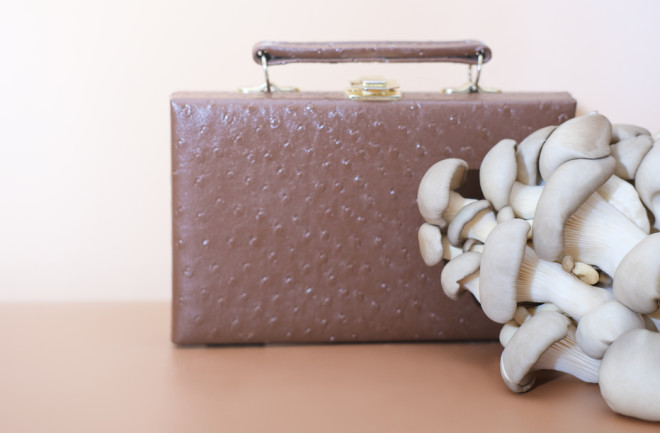It may look and feel like leather, but the material working its way into select handbags, clothes and shoes these days isn’t from animals — it’s from fungus.
Engineers and new brands are looking for more sustainable products that still resemble traditional, livestock-produced counterparts. And when it comes to replacement leathers, versions made of mushroom are leading the way. Start-ups around the world are growing and shaping their version of the flat, flexible fungus mats, and producing better versions all the time. One from the company Bolt Threads has even attracted interest from luxury fashion designers and other high-end labels.
But, while it’s tempting to assume a bag made of microbes is inherently better for the planet, mushroom leather might have some of the same sustainability issues as its animal leather counterparts.
Making Microbes Chic
Mushroom leather is part of a suite of so-called vegan leathers, or versions that aren’t reliant on any animal byproducts. Traditional leather manufacturing comes with some serious environmental costs. Livestock, which are mostly raised to satisfy animal protein appetites, account for 14.5 percent of human-generated carbon emissions. Even if leather manufacturers rely on animal skins that are cast off from food production, the tanning process often includes heavy metals and other pollutants that seep into water and the environment.
Mushroom leather brands pitch the product as a solution for leather enthusiasts who are conscious of the environmental impact of their favorite material. Instead of needing acres of land and tons of grain to raise cattle, mushroom leather makers cultivate giant mats or vats of fungus feeding off beet sugar, molasses or other industrial byproducts like sawdust. When grown on a flat surface, the mature fungus can be sliced off and dehydrated before chemical and physical treatments make it look and feel like leather.
Some of the mushroom mats do a good job of mimicking animal skin, too. When taking close-up images of a particular mushroom leather material, a research team from Florida International University in Miami found that the material likely draws some of its durability from a network of strands called hyphae — tiny fibers typically used by mushrooms to consume nutrients. Stress tests showed the mushroom material was less strong than suede, but fairly good at stretching under strain.
Jakob Hildebrandt, an environmental engineer at the Zittau/Görlitz University of Applied Sciences in Germany, has been studying future applications of mushroom leather — and happens to have a mushroom leather baseball hat made by Amadou Leather, which he wore when he popped on for a recent Zoom call. Though it wears well in the summer and helps wick away sweat surprisingly well, even a bit of rain soaks right into the material and makes it sticky, he says.
Making Sense of Marketing Claims
Hildebrandt has been studying whether or not mushroom leathers or other similar materials, such as fabric made from pineapple husks, can live up to their sustainability claims. Every stage of a faux leather’s lifetime determines the environmental impact the product has, explains Hildebrandt. He and his colleagues simulated the creation and lifespan of several vegan leathers and compared the hypothetical climate and pollution-related consequences of each material to those of real cow leather. For example, the team assessed how much land was required to make plant-based leathers compared to animal-based options, and what greenhouse gases each option produced.
While fungal leathers could harm the environment less than normal leather, the difference hinges on the choices manufacturers make along the way. “It depends on logistics,” Hildebrandt says. “How you harvest it, how you ship it, how you mulch it, how you refine it,” even how the product needs to get treated to withstand other microbes that latch on. Each step makes a difference.
The intended use of the final product changes the sustainability math, too. Some plant leathers would have to be more durable — and maybe receive a range of treatments that come with their own environmental trade-offs — if they were to replace animal skins. Fungus-based boots worn daily might need weatherproofing, unlike, say, a luxury handbag that owners tote around once every few months.
Some of the fungus leather modifications that increase the product sustainability might be surprising. When assessing other vegan leathers in their study, including versions made from plant husks, Hildebrandt and his team compared products designed as substitute leather chair upholstery. The team found that vegan leathers coated with a fossil-fuel based strengthening agent — and destined for a landfill or incinerator — had a lower environmental impact than versions not treated and compostable. The protective treatment would stretch the fake leather lifespan long enough to outweigh the benefits of compostable chair upholstery, which owners would replace more often.
The result of this comparison could mean that consumers might find themselves facing suspicious mushroom leather sustainability claims, Hildebrandt says. A manufacturer might want to bill their product as “compostable” because the concept appeals to customers. But being able to market on buzzwords like compostability doesn’t necessarily mean the item for sale is as sustainable as it could be. And any efforts towards long-term durability of mushroom leather would struggle in the fast fashion industry, which relies on customers constantly replacing their wardrobe with short-lived items.
Ultimately, some applications of mushroom leather — and all leathers — might reach their peak sustainability levels by simply lasting a long time. Durability or design to make products repairable has faded away in many areas of manufacturing, a problem that could be solved with “a cultural change in how we approach the use phase,” Hildebrandt says. Items built to last and clarity in marketing claims might be what serves mushroom leather, or any so-called sustainable product, best.

